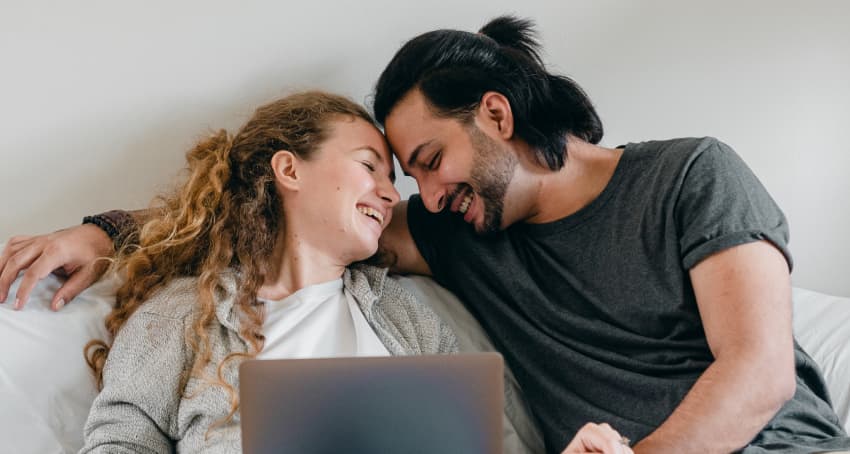Introduction
Come one come all and gather ’round, for we are about to embark on a journey of mythbusting and stereotype-shattering! You’ve likely heard the age-old question: “What do women want from men?” Well, buckle up, because we’re about to dive into the fascinating world of relationship research and uncover the truth behind the myths.
The Allure of Stereotypes
Let’s face it, stereotypes are attractive. They offer a simple, straightforward answer to complex questions. “Women want a man who’s tall, dark, and handsome,” “Men only care about looks,” – sound familiar? These generalizations are pervasive in our society, perpetuated by movies, magazines, and well-meaning friends. But here’s the thing: they’re not entirely accurate.
The Research Says…
Here’s where things get interesting. While popular culture might have you believe that men and women are from different planets, research suggests otherwise. Studies have shown that when it comes to relationship preferences, men and women are more alike than different[1]. But those findings seldom make front-page news.
In addition, in the world of academia, the phrase “publish or perish” looms large over researchers and professors alike. This intense pressure to consistently produce published work in order to secure tenure, funding, and prestige has led to an unfortunate side effect: a proliferation of research that may be less than groundbreaking.
So, even slight gender differences are broadcast as if they are earth-shattering findings, and it takes a thoughtful reader to challenge the assumptions being made and ask the question “So what?!”
And news outlets and bloggers looking for something edgy to write about spend time writing about “research findings” that are really pretty irrelevant in the larger scheme of things. They’re often based upon an uninspired finding about a slight difference between how college male and female freshmen answer a particular research question. That’s not how true scientific findings are uncovered, but it is the way that stereotypes are maintained.
Gentlemen Prefer Blondes
In one of my graduate programs, we were asked to select a piece of research and critique it. The piece I chose was noteworthy for what it didn’t say in the discussion section. The research talked about the “Grain of Truth Theory,” which suggests that men prefer blondes and women prefer dark, handsome men. However, what the researchers failed to mention was that in this Wyoming university setting, there was a strongest dislike of “red” (Native American) skin. Despite this significant finding, the research was published anyway, and the students’ inherent racism, disguised as a “preference for skin color,” was ignored. By the way, the researcher did prove his “Grain of Truth Theory” based upon his research “findings.”
Women Want Men with High Status, Right?
Take, for example, the notion that women prioritize a partner’s earnings and status above all else. While some studies have found a slight trend in this direction, the difference is much smaller than stereotypes suggest[2]. In fact, factors like kindness, intelligence, and emotional connection are consistently rated as important by both men and women[3].
The Allure of Stereotypes: A Closer Look
Stereotypes, as alluring as they may be, often lead us down a path of self-doubt and insecurity. When we internalize these oversimplified generalizations, we risk shaping our self-conception in harmful ways, especially when we don’t fit into these narrow molds.
- Marge’s Story: Marge believed that men only wanted attractive women, but these standards demanded an impossibly perfect appearance. She spent hours in front of the mirror, critiquing every perceived flaw, convinced that her worth was tied to her looks. Marge’s self-esteem plummeted as she struggled to fit into an unrealistic ideal perpetuated by society’s stereotypes.
- Tom’s Tale: Tom grew up hearing that “real men” were always strong, stoic, and in control. He felt ashamed of his emotions and hesitated to seek help, even when he was struggling with depression. The stereotype of the “tough guy” prevented Tom from embracing his vulnerability and seeking the support he needed.
- Kara’s Conundrum: Kara was a brilliant engineer, but she constantly doubted her abilities because of the stereotype that women were less competent in STEM fields. But she was also in a bind, because the “myth” told her “men didn’t like women that were too intelligent.” Despite her achievements, she felt like an imposter, questioning whether she truly deserved her success or even if she wanted it.. The gender stereotype undermined Kara’s confidence and held her back from reaching her full potential.
- David’s Dilemma: David was a nurturing, empathetic man who loved working with children. However, he hesitated to pursue a career in early childhood education because of the stereotype that it was a “woman’s job.” When he dated, David felt he had to project strength and certainty, rather than his truer nature. David felt torn between his passion and society’s expectations of what a man should do for a living or be in reference to women.
- Emily’s Expectations: Emily bought into the stereotype that women should prioritize family over career. She felt immense pressure to get married and have children, even though she was thriving in her job and wasn’t ready for that step. Emily’s adherence to this stereotype caused her to question her own desires and life choices.
- Alex’s Assumptions: Alex, a successful businesswoman, assumed that all men were intimidated by strong, independent women. She held back in her relationships, afraid to be her authentic self. Alex’s belief in this stereotype prevented her from forming genuine connections and finding a partner who appreciated her for who she was.
These stories illustrate how stereotypes can shape our self-conception in detrimental ways. When we don’t fit into these narrow boxes, we may feel inadequate, ashamed, or confused. We may limit ourselves and our potential, all because of some arbitrary societal expectation or foolish research finding.
But here’s the truth:
Stereotypes are just that – oversimplified generalizations that fail to capture the beautiful complexity of human beings. We are all unique individuals with our own strengths, weaknesses, desires, and dreams.
By recognizing the allure of stereotypes and actively challenging them, we can break free from their harmful influence. We can embrace our authentic selves and celebrate the diversity of human experience.
So, the next time you find yourself feeling pressured to fit into a stereotype, remember: you are so much more than a simplistic label. You have the power to define your own identity, to pursue your passions, and to love yourself exactly as you are.
The Individuality Factor
Now, I know what you might be thinking: “But I know a woman who only dates tall men!” or “My friend’s boyfriend is obsessed with looks!” And you’re right, individual preferences do exist. However, these preferences are shaped by a complex mix of personal experiences, cultural influences, and unique circumstances[4].
The truth is, there’s no one-size-fits-all answer to what women (or men) want in a relationship. We’re all beautifully unique individuals with our own desires and needs. Some women may prioritize a partner’s sense of humor, while others may value emotional depth. Some men may be drawn to physical attractiveness, while others may seek intellectual stimulation.
Challenging Harmful Stereotypes
While it’s all too easy to laugh off stereotypes as harmless generalizations, they can have real consequences. When we buy into the idea that all women are gold-diggers or all men are shallow, we limit our ability to form genuine, fulfilling connections[5].
Stereotypes can also lead to unrealistic expectations and disappointment. If a woman believes that all men should be chivalrous knights in shining armor, she may be setting herself up for disappointment when her partner turns out to be a regular human being with flaws and quirks.
The Key to Relationship Satisfaction
So, what’s the secret to a happy, healthy relationship? Communication, my friends. Honest, open communication. Instead of relying on stereotypes to guide your relationship expectations, take the time to talk to your partner about their individual needs and desires[6].
Ask questions, listen actively, and be open to feedback. By creating a safe space for vulnerability and understanding, you’ll be well on your way to building a relationship that works for both of you.
Let’s work together to create a world where stereotypes lose their allure, and individuality reigns supreme. A world where Marge can embrace her unique beauty, Tom can express his emotions without shame, Cara can thrive in her chosen field, David can follow his passion, Emily can make her own life choices, and Alex can be her authentic self in relationships.
Together, we can shatter these stereotypes and create a more inclusive, understanding society. One story at a time.
Conclusion
In conclusion, the notion of “what women want from men” is a complex tapestry of individual preferences, cultural influences, and personal experiences. Stereotypes may be alluring, but they rarely paint a complete picture.
So, the next time someone tries to tell you that all women want a “bad boy” or all men are emotionally unavailable, remember the power of individuality. Embrace the unique qualities that make you and your partner special, and always, always keep the lines of communication open.
References
[1] Hyde, J. S. (2005). The gender similarities hypothesis. American Psychologist, 60(6), 581-592. https://doi.org/10.1037/0003-066X.60.6.581
[2] Eastwick, P. W., & Finkel, E. J. (2008). Sex differences in mate preferences revisited: Do people know what they initially desire in a romantic partner? Journal of Personality and Social Psychology, 94(2), 245-264. https://doi.org/10.1037/0022-3514.94.2.245
[3] Buss, D. M., & Barnes, M. (1986). Preferences in human mate selection. Journal of Personality and Social Psychology, 50(3), 559-570. https://doi.org/10.1037/0022-3514.50.3.559
[4] Eastwick, P. W., Luchies, L. B., Finkel, E. J., & Hunt, L. L. (2014). The predictive validity of ideal partner preferences: A review and meta-analysis. Psychological Bulletin, 140(3), 623-665. https://doi.org/10.1037/a0032432
[5] Regan, P. C., & Anupama, J. (2003). Ideal partner preferences among adolescents. Social Behavior and Personality: An International Journal, 31(1), 13-20. https://doi.org/10.2224/sbp.2003.31.1.13
[6] Vangelisti, A. L. (2012). Interpersonal processes in romantic relationships. In M. L. Knapp & J. A. Daly (Eds.), The SAGE handbook of interpersonal communication (4th ed., pp. 597-631). SAGE Publications.


